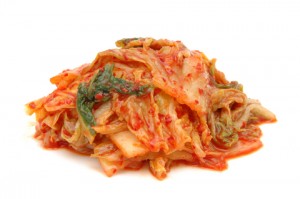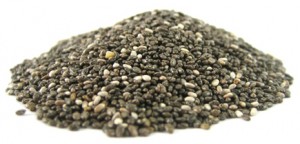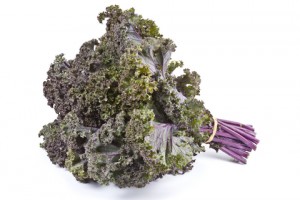Category — Healthy Living
For Your Health: Kimchi

L. was sick for 5 days straight – some dumbed-down version of the swine flu, maybe, or maybe just some other pesky virus. She recovered Monday night, but I felt like I was going down. So I reluctantly cancelled plans to see “Precious” with “the girls,” and went foraging in the fridge for dinner. In my mish-mash-hodge-podge of items was a favorite: Kimchi. ‘Cause as you may remember, when the chips are down for me health-wise, I like to treat my body as best I can . . . and kimchi is pretty much as healthy as it gets.
So . . . what is it? Kimchi is Korea’s most representative food – served at pretty much every meal. Essentially, it’s fermented vegetables – often made with cabbage, radishes, garlic, scallions and leeks, each with its own health benefits. But because it’s fermented, kimchi provides the health benefits of the veggies, plus, it can lower cholesterol, improve digestion, provide essential vitamins and minerals and provide a great, non-dairy source of live probiotics.
You’ve probably heard about probiotics – they’ve been in the news a lot lately. You mostly hear about supplements and yogurt. Probiotics are the beneficial bacteria that aid in maintaining the balance of microorganisms in your body’s intestinal tract. On average, the human digestive system contains more than 400 types of probiotic bacteria. These all serve to inhibit the growth of dangerous bacteria by promoting the health of the digestive system. And did you know that kimchi has more lactic acid bacteria than yogurt? It does!
What can kimchi do for you?
-
Kimchi helps reduce indigestion and gas. Excess bad bacteria causes irritation leading to indigestion, gas and fluid retention.
-
Kimchi may help you feel less hungry. Lactobacillus, one common strain of good bacteria, has been linked to appetite control. Good bacteria helps stabilize blood-sugar levels which means less frequent and less intense hunger.
-
Some studies have shown that kimchi can shorten the duration of a cold.
-
The juice and salt from kimchi helps to keep the intestines clean.
-
The chili peppers and garlic help to lower blood cholesterol and are an aid in blood-clotting.
How do you eat kimchi? Really, any way you like. The other night, I had it with chicken tenders and roasted root veggies. But in addition to eating kimchi as a side dish, it’s also served as kimchi stew, kimchi soup, kimchi dumplings, kimchi stir fried rice, etc. etc. etc.
You can make your own kimchi, but I’m lazy. I get my everyday kimchi at Whole Foods, but if you’re in the area and want an adventure, the new HMart in Burlington has an entire wall of kimchi . . . so you can sample different varieties, with absolutely NO health-downside to your nibbling. What could be better?
November 25, 2009 3 Comments
Healthy Breakfast Inspiration

You’ve heard it over and over and over again: Breakfast is “the most important meal of the day.” Maybe you’re like me, and you make time to eat breakfast every day . . . I can’t imagine getting up and out without putting something in my belly. But maybe you’re one of “those people” who doesn’t like to eat in the a.m. If you don’t eat breakfast at all, I urge you to try to eat a little something – you might find these two bits of new research encouraging. In one, UK researchers found that when they gave thirty-two volunteers breakfast, or made them skip breakfast, the ones who ate did better on a memory test. In another, a University of Georgia study found that eating breakfast along with 200 mg. of caffeine improves cognitive performance and mood. Now, who among us doesn’t want to be smarter and happier? [Read more →]
November 24, 2009 2 Comments
I’m Experimenting: Ch-Ch-Ch-Chia Seeds

We’re going to start the week on a healthy note. Let’s take a little break from Thanksgiving prep to talk about a new adition to my diet, chia seeds. Have you heard of chia? You might remember Chia Pets, the cute little terracotta figurines you smear with seeds to help them grow “fur.” These are the same seeds, but don’t pilfer your pet’s stash – those seeds aren’t consumption grade. The ancient seeds are actually packed with rich nutrients. Chia seeds are a genus of the mint family, originating in Mexico’s central valley and were widely cultivated by Aztec cultures in pre-Hispanic times. Chia seeds were often used as currency for tax payments to nobility and as offerings for the Priesthood. They’re so nutritious that one tablespoon of seeds was believed to sustain an individual for 24 hours!
Chia is gluten-free, with very high concentrations of omega-3 fatty acids (ALA), significant levels of antioxidants, dietary fiber, oil, protein, calcium, phosphorous, and potassium. Two tablespoons of my Navitas Naturals chia powder have 70 calories, 4.5 grams of fat, 6 grams of fiber and 3 grams of protein.
So, why would a person choose chia over flax, another vegetarian source of omega-3′s? Chia actually has a slightly higher concentration of omega-3 fatty acids than flax. Another advantage of chia over flax is that chia is so rich in antioxidants that the seeds don’t deteriorate, so they can be stored for long periods without becoming rancid. And, unlike flax, chia doesn’t have to be ground to make its nutrients available to the body.
Another big reason to choose chia over flax is phytoestrogens. Are your eyes glazing over? Stick with me here! Those of you who’re living with breast cancer probably are already aware of phytoestrogens – they’re plant-based estrogens that may or may not mimic the natural estrogens in our body and therefore raise our estrogen levels. You can also find ‘em in soy, which is why a lot of women who’ve had breast cancer avoid or limit their soy consumption. Whether or not phytoestrogens raise your natural estrogen levels is still controversial, and I’ve heard differing opinions from reputable sources. So what’s the best alternative? Chia seed. Chia contains no phytoestrogens. And since it’s just as good, if not better source of ALA, why not use chia instead?
Another note – you can’t compare the omega-3 fatty acids in chia (or flax, for that matter) to the omega 3’s you get from salmon. It’s like comparing apples to oranges. The type of omega 3 in chia (and flax) is alpha-Linolenic acid, or ALA, which is different from the omega 3’s in fish – DHA and EPA – needed for optimal health. ALA must be converted in the body to DHA and EPA – so you need to eat seven times the amount of ALA to get 1 gram of DHA. That’s a helluva lot of chia. The bottom line here is that chia is a nutritious whole food and a good addition to a healthy diet. For a great all-around, but easy to understand primer on omega 3′s, take a look at this great post from Foodicate.
Whaddaya do with chia, anyway? Chia has a nutty, but unobtrusive flavor. You can mix the whole seeds in water and add lime or lemon juice and sugar to make a drink known in Mexico and Central America as “chia fresca.” As with ground flax, you can sprinkle ground or whole chia seeds on cereal, in yogurt or salads, or grind them and mix them with flour for making muffins or other baked goods. I’ve only tried them in smoothies, so far, and I will admit that I don’t foresee making baked goods with chia . . . I think that all the butter and sugar I use would negate any health benefit of the chia, frankly!
How ‘bout you? Have you tried chia? How do you incorporate these super-seeds into your diet?
November 9, 2009 No Comments
Veggie Abundance!

Happy Saturday, all. Today was beautiful ’round Boston - crisp, dry and brilliantly sunny. This afternoon, I picked up my first Shared Harvest CSA distribution and wowza! do I have some gorgeous looking stuff to prepare in the coming weeks.
Here’s what I got:
- Brussels sprouts
- Carrots
- Parsnips
- Sweet red peppers
- Radicchio
- White potatoes
- Sweet potatoes
- Yellow onions
- Garlic
- Baby bok choy
- Escarole
- Napa cabbage
- Spinach
- Cilantro
- Red radishes
- Red and green leaf lettuce
- Hakeuei turnips
- Butternut squash
- Leeks
- Rutabaga
- Kohlrabi
- 10 lbs. of assorted apples
- 1 lb. of black calypso beans
A ton of stuff. I’ve already mapped out some recipes for the coming week, including garlicky lentil soup, roasted lettuce, roasted radishes, curried Hakurei turnips, lentils with butternut squash and walnuts, pork tenderloin stir-fry with baby bok choy and clementines, and mmmm, a warm escarole salad with apples, candied walnuts and Saint Andre cheese. Can’t wait!
I’ll be posting recipes and providing commentary as I go along – there are a few things here I’ve never had . . . . Stay tuned!
November 7, 2009 4 Comments
Frustration, And Its Antidote

Did you notice? No post at 9 a.m. today? I’d drafted a post about my newfound love, chia seeds, but somehow WordPress had other ideas and deleted all but three lines . . . discovered this at 9 p.m. last night and was just too beat (L. up at 5 a.m., thank you time-change!) to regroup and redraft. Lesson learned.
So this’ll have to be quick – I’ve got PT soon and a bunch of errands on tap today – I promise I’ll get back with a better thought-out post tomorrow!
I was p*ssed off this morning about the post, and had scheduled myself to ride the bike at the gym today (pool was closed, double grrr) . . . so what did I do? I took out my anger on the bike (D. & L. will thank me later). I have to say, it was one of the best rides I’ve had in a while, and that’s saying something since I ride the bike a lot.
To what do I attribute my success this morning? Two things – first, I got a great night’s sleep last night, so I was rested and strong. Second, I decided to switch up my music today and cycle to a Podrunner mix. You may remember this post on workout music, I mention the Podrunner mixes there.
Today’s mix was called “Upgrade*,” and it is a 140-170 BPM mix. You can look it up in the archives that are right on the Podrunner home page. This mix gradually increases in tempo as you get further through the hour. It helped me go faster and longer today – I’ve figured out, finally, where to set my bike so that I can spin fast, with lower resistance, and still keep my heart rate in the zone . . . in the “old days,” before foot issues, I used to cycle with a lot more resistance, but at a slower RPM. So actually now, the Podrunner mixes are even better for me than they were before!
I urge you to check ‘em out – you don’t need an iPod, just a MP3 player. You can subscribe on the site and be up-to-date on the latest mixes (now bi-weekly due to budget issues), or if you do have an iPod, you can just subscribe and you’ll be scheduled to download new mixes as they become available.
And if you like what you hear, do us all a favor and donate to Podrunner . . . they’re remarkably well-thought-out mixes for a fraction of what you’d pay to download and create your own playlist.
Happy sweatin’!
*P.S. Another one of my favorites is a 140 BPM mix called “Progressive.”
November 2, 2009 2 Comments
A Follow-Up To The Environmental Working Group’s Cell Phone Radiation Study

The EWG’s follow-up report was published yesterday – check it out here. It reiterates that there is reason for concern – and that some changes in how we use our phones to reduce exposure (especially in kids) are warranted.
October 29, 2009 1 Comment
More Good-For-You Greens: Kale

This short but pointed post about the nutritional benefits of kale on Andy Bellatti’s blog “Small Bites” was perfectly timed – that night we were scheduled to eat one of my all-time favorite quick-n-easy kale recipes – chicken sausage with bulgur and kale. This recipe is a pain-free way to introduce this nutrient powerhouse into your diet: It’s a pretty, nutritious, one-dish meal you can serve your family in 30 minutes or fewer – what’s not to love??
Sausage With Bulgur and Kale
1 (12 oz.) Package fully cooked chicken sausage with roasted red pepper (I use Hans’ from Whole Foods), each sausage halved lengthwise, then sliced into 1-inch thick slices 1 Bunch kale – any type (purple looks pretty) – coarsely chopped 1 t. Bottled crushed garlic (or 3-4 cloves of minced garlic) 14.5 oz. Low-sodium chicken broth (one can, or if you’re trying to avoid BPA, use broth packed in aseptic packs) 1 c. Bulgur 1/2 t. Kosher salt 1/2 t. Freshly ground black pepper 1 Pint grape tomatoes, halved 2 T. Grated Romano cheese
Spray a large skillet with cooking spray and set over high heat. Add the sausage and brown, stirring frequently. Transfer to a plate. Reduce the heat and add the kale and garlic to the skillet and cook, tossing frequently, until the kale is wilted (see note below). Stir in the broth, bulgur and sausage – your liquid will not cover the mixture entirely – don’t panic! Cover and bring just to a boil, then reduce the heat and simmer for 5 minutes. Remove the skillet from the heat and let the mixture stand, covered, until the liquid is absorbed and the bulgur is tender, about 5 minutes more. Fluff the mixture with a fork, stir in the tomatoes and cheese, and serve! Serves 4.
A couple of notes. If you haven’t cooked kale or any other sturdy leavy green before, you need to know it’s bulky. You will probably have to add 1/2 the kale to the skillet and toss it around (tongs are a great tool for this) until it wilts a bit, then add more, wilt, etc., ’til you can get it all in the pan. It’s always stunning to see how much it reduces in volume.
Next – this is the second recipe I’ve posted with bulgur as an ingredient, and I’m thinking now that many of you might not be familiar with this nutritious and versatile grain. I grew up eating bulgur. Mostly, I think, because I’m part Lebanese. But as you can see, bulgur doesn’t need to be limited to Middle-Eastern cooking. It’s got much more bang-for-the-buck nutritionally than rice or couscous, and it’s just as easy to prepare. For more about bulgur, click here, here and also here.
October 19, 2009 3 Comments
Guest Post: Finding Joy In Jill
Today I’m proud to announce my first guest blogger, Jill Feldman. Jill’s going to tell us about a passion of hers, Nia – a workout, lifestyle and personal growth program all rolled into one. Many, including Jill, have found that Nia’s a fabulous way to condition, heal and transform the body, mind and spirit.
Maybe Jill will inspire you to try Nia? It can be incredibly refreshing for your body and your mind to take up a new form of exercise after many years of doing the same ol’ thing. I’m going to try it out and I’ll keep you posted – Jill is going to lead me in a special Nia session adapted to my current zero weight-bearing exercise restrictions . . . yes, you can even do Nia in a chair! [Read more →]
October 14, 2009 No Comments










